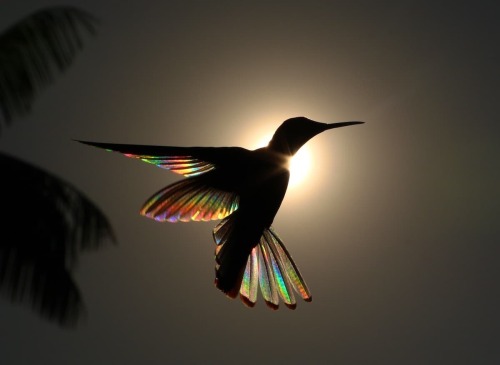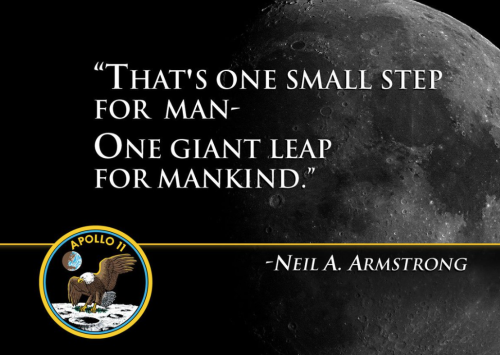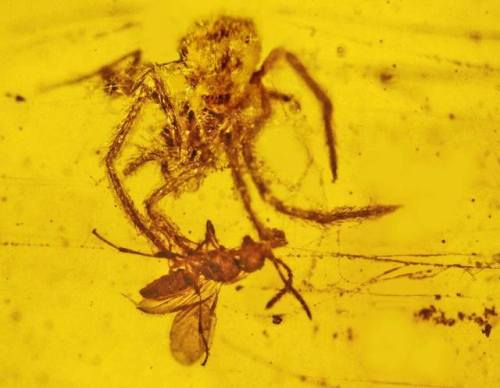What Did South Eastern Australia Look Like 130 Million Years Ago? This Watercolour Landscape Is Part

What did South Eastern Australia look like 130 million years ago? This watercolour landscape is part of my on going work recontructing fossils discovered last summer in Boola Boola Forest, Gippsland Victoria. They date back to the Early Cretaceous period - the golden age of the dinosaurs.
.
On our dig we found fossils of every species shown in this illustration. The plants in the foreground and fossil shown here is Otozamites douglasii, a member of the cycad-like Bennettitales which are completely extinct now. However the rest of the scene depicts plants that have similar modern decendants: Cladophlebis ferns down low, a forest of conifers including Bellarinea richardsii (Podocarp family), and very tall Brachphyllum tyersensis (Belonging to either the Araucaria or Cypress family).
More Posts from Rocks-everywhere and Others



A Rainbow of Light Diffracts Through Hummingbird Wings in Photographs by Christian Spencer

This mysterious hole nearly swallowed a 6-year-old boy
On the south shore of Lake Michigan there are a series of large sand dunes that create the Indiana Dunes National Lakeshore. The dunes are a consequence of winds blowing sand along the length of Lake Michigan and the lake level dropping over time and exposing the shorelines. The largest is known as Mount Baldy, a 40-meter high pile of sand that is not anchored by vegetation and migrates side to side every year depending on the winds.
In July 2013, a Northwestern Illinois family including 6-year-old Nathan Woessner was hiking along the dune on vacation. Suddenly, Nathan vanished and all that was left was this hole. Adults reached in and couldn’t feel the boy or reach his hands.
Keep reading
“nothing to see here.” - The Field Museum of Natural History
museums are giving us quality quarantine content
it is starting to bloom outside!!! smell like earth and worms!! the grass is tall and awake!!! flowers are here and scattered everywhere!!! it’s raining and humid and fresh!!! i know i say this every other day!!! i love!!! spring!!!
Obi on Shane Madej’s instastory on April 29, 2019.
[s]ome [o]ld [h]ippie [c]aught [a]nother [h]ippie [t]ripping [o]n [a]cid
How the media depicts the Apollo 11 mission:

Actual quotes from the Apollo 11 mission:






A predatory moment, frozen in geological time
You’re a hungry spider who is rushing towards a wasp that has become entangled in your web when all of a sudden everything goes sticky, you can’t move, frozen in place like the proverbial Tantalus with your food in sight but forever beyond your reach. Very soon after you are engulfed in another wash of sticky sap oozing out of a tree and everything goes dark. The spider may ironically have also been courting a painful death, since these wasps are parasitic and known to lay their eggs in spiders and other insects, with the larvae slowly consuming the insect from the inside out, preserving it alive by leaving the vital organs for last. Such a moment was caught by a unique fossil pictured below, that turned up in a hundred million year old piece of amber from what is now the Hukawng valley in Burma.
Keep reading
Me writing: “She knew she had to go in this town called…”
My brain:

.
-
 cryptidcrone reblogged this · 1 month ago
cryptidcrone reblogged this · 1 month ago -
 rigatoney reblogged this · 1 year ago
rigatoney reblogged this · 1 year ago -
 rigatoney liked this · 1 year ago
rigatoney liked this · 1 year ago -
 zapiecek reblogged this · 1 year ago
zapiecek reblogged this · 1 year ago -
 zapiecek liked this · 1 year ago
zapiecek liked this · 1 year ago -
 redekpal3oart reblogged this · 1 year ago
redekpal3oart reblogged this · 1 year ago -
 redekpal3oart liked this · 1 year ago
redekpal3oart liked this · 1 year ago -
 paleoartchive reblogged this · 1 year ago
paleoartchive reblogged this · 1 year ago -
 timpaxew reblogged this · 1 year ago
timpaxew reblogged this · 1 year ago -
 timpaxew liked this · 1 year ago
timpaxew liked this · 1 year ago -
 cyrenaica liked this · 1 year ago
cyrenaica liked this · 1 year ago -
 jhanettesticle reblogged this · 1 year ago
jhanettesticle reblogged this · 1 year ago -
 nostalgiagarden reblogged this · 1 year ago
nostalgiagarden reblogged this · 1 year ago -
 un-monstre liked this · 1 year ago
un-monstre liked this · 1 year ago -
 worstpunk liked this · 1 year ago
worstpunk liked this · 1 year ago -
 foxboyclit liked this · 1 year ago
foxboyclit liked this · 1 year ago -
 thevastnessof reblogged this · 1 year ago
thevastnessof reblogged this · 1 year ago -
 stedestits reblogged this · 1 year ago
stedestits reblogged this · 1 year ago -
 stedestits liked this · 1 year ago
stedestits liked this · 1 year ago -
 beeps-boops reblogged this · 1 year ago
beeps-boops reblogged this · 1 year ago -
 allosuchus reblogged this · 1 year ago
allosuchus reblogged this · 1 year ago -
 bigdreams-and-crazyplans reblogged this · 5 years ago
bigdreams-and-crazyplans reblogged this · 5 years ago -
 bigdreams-and-crazyplans liked this · 5 years ago
bigdreams-and-crazyplans liked this · 5 years ago -
 alanaartdream liked this · 5 years ago
alanaartdream liked this · 5 years ago -
 theglacierhouse liked this · 5 years ago
theglacierhouse liked this · 5 years ago -
 aussiebotanist liked this · 5 years ago
aussiebotanist liked this · 5 years ago -
 khsteppe liked this · 5 years ago
khsteppe liked this · 5 years ago -
 en--dear reblogged this · 5 years ago
en--dear reblogged this · 5 years ago -
 cactus-pat liked this · 6 years ago
cactus-pat liked this · 6 years ago -
 yugdups liked this · 6 years ago
yugdups liked this · 6 years ago -
 man7100 liked this · 6 years ago
man7100 liked this · 6 years ago -
 rocks-everywhere reblogged this · 6 years ago
rocks-everywhere reblogged this · 6 years ago -
 good-night-space-kid liked this · 6 years ago
good-night-space-kid liked this · 6 years ago -
 boana1527 liked this · 6 years ago
boana1527 liked this · 6 years ago -
 welkynd-virydiis liked this · 6 years ago
welkynd-virydiis liked this · 6 years ago -
 lostintheozoneagain2 liked this · 6 years ago
lostintheozoneagain2 liked this · 6 years ago -
 meridianowl reblogged this · 6 years ago
meridianowl reblogged this · 6 years ago -
 nekomiser liked this · 6 years ago
nekomiser liked this · 6 years ago -
 rainingrosebuds liked this · 6 years ago
rainingrosebuds liked this · 6 years ago -
 dontjudgedontjudge liked this · 6 years ago
dontjudgedontjudge liked this · 6 years ago -
 skysolo reblogged this · 6 years ago
skysolo reblogged this · 6 years ago -
 skysolo liked this · 6 years ago
skysolo liked this · 6 years ago -
 big-time-tradie liked this · 6 years ago
big-time-tradie liked this · 6 years ago -
 emykay-things reblogged this · 6 years ago
emykay-things reblogged this · 6 years ago -
 zabmurmur45 liked this · 6 years ago
zabmurmur45 liked this · 6 years ago -
 hardboiledkittens liked this · 6 years ago
hardboiledkittens liked this · 6 years ago -
 krestelagin liked this · 6 years ago
krestelagin liked this · 6 years ago
225 posts